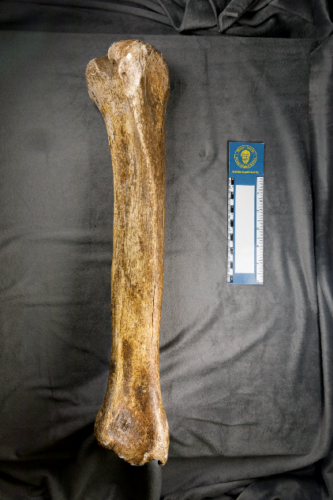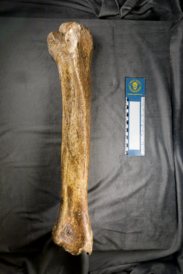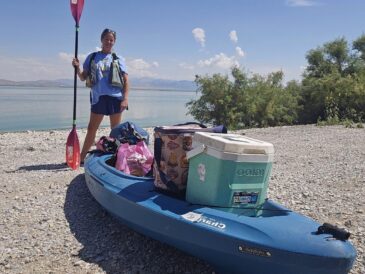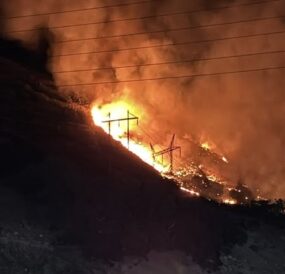Around Utah: Ice Age came fossil found along the Green River in Utah

John Foster/Utah State Parks
33,000 year old tibia (shin bone) of Camelops hesternus from near Vernal, Utah.An old fossil discovery is providing new information to scientists nearly 40 years later. A fossil bone found in a sand pit near Vernal, Utah, in the 1980s has turned out to be an older-than-expected representative of a species of camel that was common in the region during the Ice Ages. A team of independent and Utah State Parks scientists published the results of the study in the journal Historical Biology this summer.
The bone was found buried in sand and pebbles near the Green River, south of town, in 1987. It was then brought to the Utah Field House of Natural History State Park Museum, where then Park Manager Alden Hamblin identified it as the shin bone of a camel. It has been on display at the Utah Field House for several decades, explicitly identified as the camel Camelops hesternus by retired Bureau of Land Management paleontologist and mammal specialist Greg McDonald. The northeastern Utah fossil’s exact age was unknown until recently.
A radiocarbon age on the bone recently revealed that the camel lived about 33,000 years ago. This indicates that the camel was here at a time dating from just before the last glacial maximum during the Ice Ages. Conditions in Utah would have been noticeably colder and wetter than they are today.
Camelops hesternus was a distant relative of today’s Arabian and Bactrian camels and lived from over 3 million years ago until just less than 10,000 years ago, disappearing around the same time as horses, mammoths, ground sloths, and other large Ice Age mammals vanished from North America. When curious Utah Field House scientists sent the bone off to be tested for its precise age, they expected it to be a late-living Camelops.
“The only other dated Utah Camelops, and most of those in the region that have actually been radiometrically dated, are from less than 20,000 years ago, almost 10,000 years ago,” said Utah Field House Curator John Foster. “We expected it to be from around 10,000 years ago, maybe 15,000 if we were lucky.”
— Utah Department of Natural Resources Division of State Parks
Utah Office of Energy Development, TerraPower and Flagship Companies Sign MOU to Explore Siting of Advanced Nuclear Reactor
The Utah Office of Energy Development (OED), TerraPower and Flagship Companies announced today the signing of a Memorandum of Understanding (MOU) to explore the potential siting of a Natrium® reactor[1] and energy storage plant in Utah.
This landmark agreement establishes a non-binding framework for cooperation among the three parties and supports Gov. Cox’s Operation Gigawatt, a strategic effort to build an energy ecosystem that serves Utah and the Western U.S. Under the agreement, OED, TerraPower and Flagship will jointly identify and assess sites for a potential advanced nuclear plant, with the goal of establishing preliminary site recommendations by the end of 2025. Site selection will be based on an evaluation of a variety of factors including community support, the physical characteristics of the site, the ability of the site to obtain a license from the U.S. Nuclear Regulatory Commission and access to existing infrastructure.
“Today marks an important step forward for energy in Utah,” said Governor Spencer J. Cox. “Operation Gigawatt is about adding capacity from diverse sources — nuclear, natural gas, geothermal and more — so families and businesses have power that is affordable, reliable and clean. This agreement with TerraPower will help keep rates low, strengthen our grid and ensure Utah’s future can be as strong as our past.”
— Utah Office of Economic Development
Celebrate 75 Years of PEANUTS by donating blood with the American Red Cross of Utah
Snoopy and the gang are back to inspire lifesaving kindness! In honor of the 75th anniversary of PEANUTS, the American Red Cross is partnering with the beloved PEANUTS characters to celebrate and thank blood donors in a special way.
From Aug. 29 to Sept. 21, 2025, those who come to give blood will receive an exclusive Red Cross x PEANUTS mystery bag containing one of four limited-edition T-shirt designs, while supplies last. Each shirt showcases an iconic PEANUTS character–but here’s the twist: donors won’t know which one they’ve received until they open the bag.
Adding to the excitement, a limited number of mystery bags nationwide will include a golden ticket. Lucky donors who find a golden ticket can redeem it online to collect all four T-shirt designs.
George E. Wahlen VA Medical Center in SLC to receive infrastructure improvements
The Department of Veterans Affairs will realign an additional $800 million this fiscal year as part of the Veterans Health Administration’s Non-Recurring Maintenance program, which makes infrastructure improvements to health care facilities to ensure safe and effective patient care.
The extra funding means more resources to repair and update aging VA facilities and technology.
The extra money will be spent on a variety of improvement projects at various VA health care facilities across the nation, including the George E. Wahlen VA Medical Center.
“This is another step forward in our efforts to make VA work better for the Veterans, families, caregivers and survivors we are charged with serving,” said VA Secretary Doug Collins. “Improved facilities, equipment and infrastructure help improve care for Veterans, and these additional funds will enable VA to achieve that goal.”
The additional funds will come from savings gleaned from various VHA reform efforts. The additions will bring total NRM program spending for fiscal year 2025 to $2.8 billion — a nearly $500 million increase from fiscal year 2024.
— U.S. Department of Veterans Affairs



